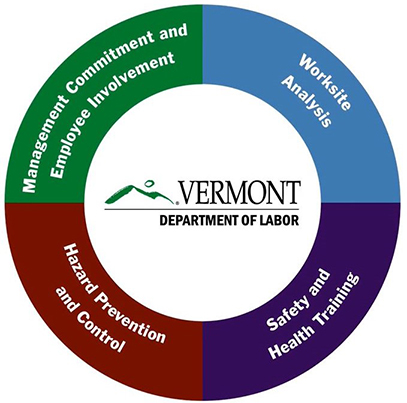The concepts outlined below provide employers, workers, and worker representatives with examples and information on how some of the best companies in Vermont are working to address safety and health issues in the workplace.

Review the content below to better understand how these companies value and emphasize safety and health programs, and how your company might be able to improve upon its own initiatives.
Employers
- Vermont Electric Co-Op
- Cabot Creamery Co-Op
- ReArch Company, Inc.
- Atlas Environmental Consulting
- General Electric (GE)
Overview
- Top management demonstrates its commitment to continuous improvement in safety and health, communicates that commitment to workers, and sets program expectations and responsibilities.
- Managers at all levels make safety and health a core organizational value, establish safety and health goals and objectives, provide adequate resources and support for the program, and set a good example.
- Workers and their representatives are involved in all aspects of the program—including setting goals, identifying, and reporting hazards, investigating incidents, and tracking progress.
- All workers, including contractors and temporary workers, understand their roles and responsibilities under the program and what they need to do to effectively carry them out.
- Workers are encouraged and have means to communicate openly with management and to report safety and health concerns without fear of retaliation.
- Any potential barriers or obstacles to worker participation in the program (for example, language, lack of information, or disincentives) are removed or addressed.
Employers
Overview
- Control measures are periodically evaluated for effectiveness.
- Processes are established to monitor program performance, verify program implementation, identify program deficiencies and opportunities for improvement, and take actions necessary to improve the program and overall safety and health performance.
Employers
- Vermont Electric Co-Op
- Cabot Creamery Co-Op
- ReArch Company, Inc.
- Atlas Environmental Consulting
- General Electric (GE)
Overview
- Employers and workers cooperate to identify and select options for eliminating, preventing, or controlling workplace hazards.
- A plan is developed that ensures controls are implemented, interim protection is provided, progress is tracked, and the effectiveness of controls is verified.
Employers
- Vermont Electric Co-Op
- Cabot Creamery Co-Op
- ReArch Company, Inc.
- Atlas Environmental Consulting
- General Electric (GE)
Overview
- All workers are trained to understand how the program works and how to carry out the responsibilities assigned to them under the program.
- All workers are trained to recognize workplace hazards and to understand the control measures that have been implemented.
